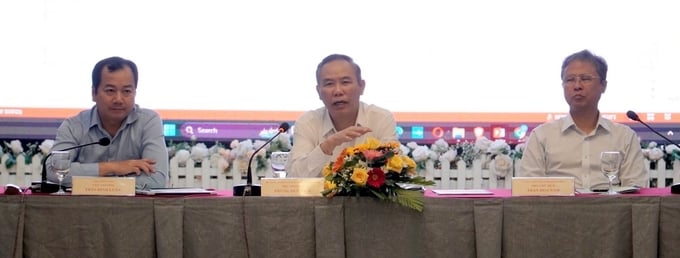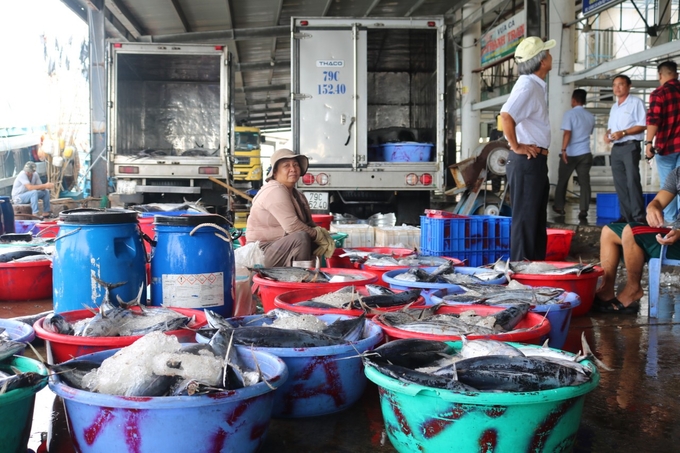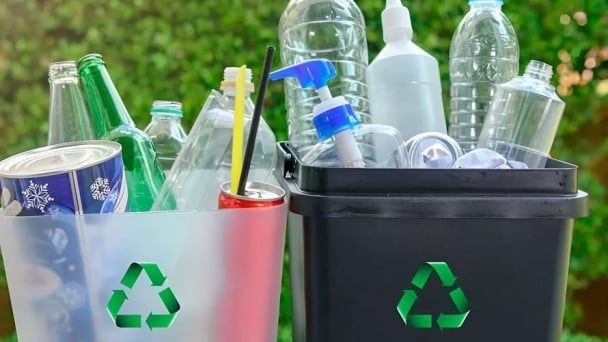May 18, 2025 | 21:27 GMT +7
May 18, 2025 | 21:27 GMT +7
Hotline: 0913.378.918
May 18, 2025 | 21:27 GMT +7
Hotline: 0913.378.918

Deputy Minister Phung Duc Tien, together with the leadership of the Department of Fisheries and the leaders of Khanh Hoa province, co-hosted a conference on the management of seafood exploitation activities at fishery ports. Photo: KS.
Recognizing the need for effective oversight, a conference was jointly hosted by Deputy Minister Phung Duc Tien from the Ministry of Agriculture and Rural Development (MARD), Director Tran Dinh Luan of the Department of Fisheries, and a Vice Chairman of the Khanh Hoa Provincial People's Committee.
Providing insights into the management of fishing activities at fishing ports, Mr. Nguyen Van Trung, Head of the Office for the Management of Fishing Vessels and Fishery Logistics Service Providers within the Department of Fisheries, reported that by October 2023, there were over 83,000 fishing vessels exceeding 6 meters in length nationwide. Of these, approximately 72,000 vessels were registered and updated on VnFishbase, including nearly 30,000 vessels exceeding 15 meters in length. Notably, around 11,210 fishing vessels remain unregistered and not updated on VnFishbase, reflecting a decrease of 3,393 vessels compared to the previous December due to damages and unidentified locations. The total number of defined and announced quotas stands at 84,125 licenses.
Mr. Nguyen Van Trung further highlighted that MARD has incorporated and announced 76 storm shelters for fishing vessels across 28 coastal provinces and cities. Among these, 18 are regional shelters, and 57 are at the provincial level, providing accommodation for approximately 50,000 fishing vessels.

Fishing boats arrive at Hon Ro port in Phuoc Dong commune, Nha Trang city. Photo: KS.
In relation to the newly announced storm refuge areas for fishing vessels, 48.63% of the planned areas have been developed, with the capacity of these newly established areas reaching 43% of the plan and accounting for 43.76% of the total number of fishing boats nationwide. This indicates a slower progress in the construction of storm refuge areas for fishing vessels than the planned targets, increasing the risk of damage to boats and lives during storms.
According to Mr. Nguyen Van Trung, despite a significant reduction in the number of fishing vessels due to development policies, initial infrastructure has received attention and investment through various medium-term public investment projects for fishing ports and approved shelter areas, which are set to commence in 2023. Progress has been made in the organization of inspections, controls on vessel entry and exit from ports, as well as the monitoring of seafood volumes through ports and the enforcement of laws, including penalties for IUU (Illegal, Unreported, and Unregulated) fishing activities.
However, challenges persist, such as inadequate infrastructure to meet industry development requirements and limited investment resources. The scale and capacity of fishing ports and storm refuge areas for fishing vessels do not meet the planned standards. Many fishing ports, built a long time ago, lack several elements required by Law on Fisheries 2017, Article 78, for effective management and task execution at the ports. Periodic maintenance and repairs are limited, with some ports experiencing sedimentation issues that hinder the safe entry and exit of fishing vessels, posing safety risks.
The organizational structure and management mechanisms of fishing ports at the local level lack uniformity. Nevertheless, the model of organizing the management of fishing ports under the Department of Agriculture and Rural Development has been successful in meeting the requirements for infrastructure management, providing optimal support for management tasks, overseeing cargo loading and unloading operations, inspecting seafood harvesting activities at ports, and verifying the origin of seafood. However, the human resources of these port management organizations are currently insufficient and lack specialized training.
Additionally, Ms. Nguyen Thi Trang Nhung, Head of the Science, Technology, and International Cooperation Department (Directorate of Fisheries), pointed out that the connection between fishing ports and purchasing and processing enterprises is not well-established. Furthermore, the IUU control office at fishing ports lacks data integration with other departments at the port.

Fishermen catch tuna and bring them to Hon Ro port for weighing before selling to the distribution outlets. Photo: KS.
Mr. Le Ba Anh, Deputy Director of the Department of Quality, Processing, and Market Development (Ministry of Agriculture and Rural Development), emphasized that meeting the stringent requirements for exporting to demanding markets such as Europe involves not only addressing IUU issues but also ensuring food safety. Proper temperature control for seafood storage on vessels is crucial, yet most of our fishing vessels use ice storage methods, which only guarantee the quality of fish for 10 to 15 days. However, many offshore fishing expeditions last much longer.
Another point raised during the EC inspection was whether officials at the fishing ports were interviewed to assess their understanding and compliance with food safety standards and conditions. Therefore, at this conference, it is hoped that the units responsible for managing fishing ports will pay more attention to ensuring food safety at the ports in accordance with regulations. Additionally, certification-granting agencies for the ports must ensure that, when errors are detected, they monitor and require corrective actions.
Mr. Tran Dinh Luan, Director of the Fisheries Department, stated that in recent times, despite limitations in terms of manpower and infrastructure, port management authorities have made efforts to implement legal regulations governing the management of seafood harvesting activities at fishery ports. This includes controlling the entry and exit of fishing vessels, ensuring that the volume adheres to regulations upon arrival at the port. However, Mr. Luan believes that many existing issues, especially those identified during the recent inspections, still need to be addressed, particularly during the 4th inspection by the EC inspection team.
According to Mr. Tran Dinh Luan, to effectively manage activities at fishery ports, in addition to investing in infrastructure, it is crucial to stabilize the organizational structure at the ports. Priority should be given to training and developing the skills of personnel working at fishery ports to ensure they possess the necessary expertise for overseeing volume, controlling vessel entry and exit, and carrying out effective monitoring.

Deputy Minister of the Ministry of Agriculture and Rural Development, Mr. Phung Duc Tien, stated that fishery ports are at the core of the effort to lift the "yellow card." Photo: KS.
Furthermore, there is a need to review the coordination process between fishery ports and the representative offices responsible for inspecting and controlling fishing activities at these ports. This ensures that timely measures are taken when existing issues are identified.
Additionally, boat captains and vessel owners bear responsibility when their vessels go offshore and dock at ports. They must provide notification, maintain fishing logbooks, activate tracking devices, and adhere to regulations. Only through such measures can the entire operation of fishing vessels be monitored in accordance with regulations, promoting transparency and traceability of the origin of seafood products supplied to processing plants, thus ensuring a sustainable and responsible fisheries industry.
In conclusion, Deputy Minister of the Ministry of Agriculture and Rural Development, Mr. Phung Duc Tien, emphasized that fishery ports are central to lifting the "yellow card" issued by the European Commission (EC). Therefore, fishery ports must manage their fleets and closely monitor them through the Vessel Monitoring System (VMS). Recently, violations primarily involved vessels losing VMS connectivity. In addition, rigorous implementation of source tracing, seafood harvesting logbooks, monitoring of seafood volumes at the port, and handling administrative violations must be undertaken seriously and not merely as a formality
Regarding equipment and the shortage of personnel at fishery ports, local authorities need to supplement resources to meet the requirements. Deputy Minister Tien expressed the hope that everyone who has made efforts will continue to strive for further improvement.
Translated by Linh Linh

(VAN) The decree on Extended Producer Responsibility (EPR) ensures transparent management and disbursement of support funds, avoiding the creation of a “give-and-take” mechanism.

(VAN) Hue City rigorously enforces regulations regarding marine fishing and resource exploitation, with a particular emphasis on the monitoring of fishing vessels to prevent illegal, unreported, and unregulated (IUU) fishing.

(VAN) Hanoi People's Committee has issued a plan on reducing greenhouse gas emissions in the waste management sector with 2030 vision.

(VAN) Vietnam's draft amendment to Decree No. 156 proposes a mechanism for medicinal herb farming under forest canopies, linking economic development to population retention and the sustainable protection and development of forests.

(VAN) In reality, many craft village models combined with tourism in Son La have proven effective, bringing significant economic benefits to rural communities.

(VAN) The international conference titled Carbon Market: International experiences and recommendations for Vietnam was successfully held recently in Ho Chi Minh City.

(VAN) According to the Project on rearranging provincial and communal administrative units, in 2025, the country will have 34 provinces/cities, 3,321 communes, wards, and special zones, and no district-level organization.